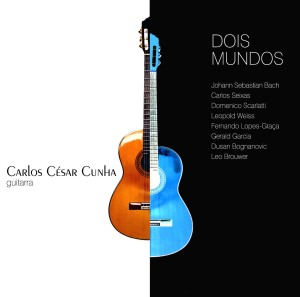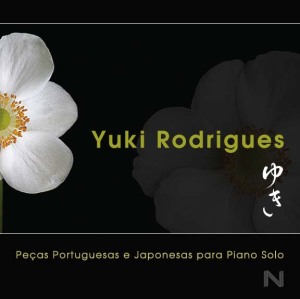NUM 1163
Title: Sonatas
Artist: Cremilde Rosado Fernandes
Composer: Carlos Seixas
The repertory of the Sonatas or Toccatas (both terms were used interchangeably) is impressively large and includes in Scarlatti’s case over 560 surviving pieces, whereas from Seixas only over 100 works of this type with proven authorship have survived, but there are good arguments that a further dozen could be included. From neither author has an autograph manuscript survived and a a clear assignment to a particular instrument, e.g. the organ, is a great exception.
More than a few European and American musicologists have already occupied themselves with the works of both composers and it seems a little strange that only a few, those more familiar with Lusitanian spirit and sensibility, have paid attention to the characteristics of the musician from Coimbra, who until recently was said by general agreement not to be able to step out of Scarlatti’s shadow. It is surely no longer appropriate, uncritically to wish to judge the works of Carlos Seixas with the same criteria as one is used to apply to Scarlatti, Soler, or Johann Sebastian Bach, as if the origin, tradition, environment or also the age of the different musicians would not have led to personality differences, techniques of their craft, and individual forms of expression.
.
NUM 1151
Artist: Carlos César Cunha
Composers: Silvius Leopold Weiss, Carlos Seixas, Domenico Scarlatti, Johan Sebastian Bach, Dusan Bognanovic, Fernando Lopes-Graça, Leo Brouwer, Gerald Garcia
Carlos was born in June, 1974, in Gaia.
In 1987 he began his official studies of classical guitar at “Curso de Música Silva Monteiro” (musical course).
Two years later he entered the Conservatório de Musica (conservatoire), concluding the 5th and 8th grade of guitar in the class of Prof. Artur Caldeira. During this period he participated in several internal and external auditions, solo recitals and concerts with the conservatoire orchestra.
He gained the 2nd award in the contest “RDP” jovens músicos (young musicians) 1995 (1st not conferred) and the 1st award (ex-aequo) in “Concurso Interno do Conservatório de Música do Porto”-1996. (internal contest in Oporto conservatoire)
Simultaneously, in terms of light music, he participated in several projects that obtained first awards in Matosinhos, Lisbon and also a 1st award in Wales, with a group connected to Universidade do Porto (Oporto College) which is dedicated to traditional Portuguese music collection, research and broadcast.
In 1996 he entered Escola Superior de Música e Artes do Espectáculo do Porto – ESMAE (Arts and Musical College), and concluded the bachelorship and graduation in the class of Prof. José Pina.
Besides ESMAE auditions, he appeared in several a solo recitals and in chamber music groups, with guitars (duos and trios), flute and singing, all over the country.
He attended improvement courses and “masterclasses” with José Pina and Alberto Ponce.
At the present he is part of the Teachers Board, where he also holds the position of Delegado de Cordas (string delegate) at Escola de Música da Póvoa de Varzim (musical school). He joined the musical department of Colégio de Nossa Senhora do Rosário do Porto.
.
NUM 1140
Title: Peças Portuguesas e Japonesas Para Piano Solo
Artist: Yuki Rodrigues
Composers: Luiz Costa, Cláudi Carneyro, Eurico carrapatoso, J. Vianna da Motta, Kosaku Yamada, Kumihiko Hashimoto, Carlos Seixas, Yuki Rodrigues, Michio Miyagi
Luiz Costa is one of the most interesting composers of the Portuguese musical modernism. Luiz Costa was born in 1879 in S. Pedro de Fralães (Minho), and died in 1960 in Porto, where he lived most of his life. His birthplace was of great importance in shaping his personality as a composer, inspiring him constantly. In this fourth piece of the cycle “Telas Campesinas, op. 6”, “Roda o Vento nas Searas”, Luiz Costa re-creates in a magnificent way the natural atmosphere of his region of birth. It is a descriptive and impressionist music.
Cláudio Carneyro was born in Porto in 1895, son of the great painter António Carneiro, he died in 1963. He began his musical studies in his hometown, and continued them in Paris with Widor and Dukas.
C. Carneyro stands out in the Portuguese musical scene for his extraordinary expressive potentiality, becoming a unique example in all of the Portuguese music. “Pavana” was composed in 1937, evoking the 6th century polyphony, but always introducing his unmistakable musical style.
“Arpa Eolea”, composed in 1948, according to the author’s affirmation, is an “impressionism attempt” and an “isolated experience” in his artistic production. “Bailadeiras”, composed in 1946, is a popular inspired small piece based on a rhythmic background evoked by the tambourine.
Eurico Carrapatoso
(L’aire de l campo fai-mos sentir bien!)
Eurico Carrapatoso was born in 1962 in Bragança district and is, without a doubt, one of the most important composers of the contemporary Portuguese music. This cycle of three solo piano pieces, “L’aire de l campo”, based in 1996 materials, was composed in 2003. The first piece “Augas Bibas”, named after a small village, means “Living Waters” in the dialect of the region and is presented as an intimate piece. It begins with apparent serenity, but the introduction of dissonant elements leads to an intense drama, only to return to the serene initial ambience. The second piece, “Palaçôlo”, also a small village, enwind us in an “old nobility” atmosphere, nostalgic and magnificent. The third piece, “Prado Gaton”, also a small village near Augas Bibas and Palaçôlo, leads us to a metaphoric and penetrating silence, through the inner time of the piece, which is a cyclic time, an infinite time. The resonance interaction creates a crystalline atmosphere in whole the piece.
José Vianna da Motta was born in the 22nd of April 1868 at S. Tomé island. One year after the family decides to departure to Portugal, settling in Colares, and later in Lisbon. He leaves to Germany in 1882, with the purpose of studying with Liszt, Han von Bulow, among others distinguished teachers of the time. He his profoundly influenced, by the music and personality of Wagner, and a true lover and connoisseur of the German literature, especially Goethe.
He was a brilliant and erudite pianist, composer, musical critic and pedagogue.
Jointly with Luiz Freitas Branco, he had great importance in the reform of the music teaching in Portugal. This piece “Valsa Caprichosa”, is included in the cycle “ Cenas Portuguesas op. 9”, inspired by popular melodies, it has the lightness of the waltz, with a slight touch of humour.
Kôsaku Yamada
The song “Machibôke” (literally “Left Awaiting”), was composed by Kôsaku Yamada with lyrics by the poet Hakushû Kitahara. This poem is based in a Chinese children’s tale. The composer wrote the piece introduction inspired in the whistle used by the Chinese carters. The version presented in this recording is a solo piano adaptation.
Kunihiko Hashimoto (1904-1949) wrote the piece “Yakyoku” (Nocturno) in October 1934. This well-known Japanese composer studied with Schonberg from 1934 to 1937. He had an intense musical activity both as a composer and maestro.
Carlos Seixas
José António Carlos de Seixas was born in Coimbra, 11th July 1704, descendant of a noble family he died in 1742. Arrived in Lisbon very young and most likely was in contact with Domenico Scarlatti, who lived in Portugal at the time. Seixas Toccatas show in fact, the influence of the master Scarlatti, but never losing his strong genuine Portuguese personality.
Yuki Rodrigues (Adaptation)
Written over two Japanese themes, “Sakura, Sakura” and “Kôjô no Tsuki”, this rhapsody is based in two of the most well known Japanese melodies. The theme “Sakura, Sakura” (cherry-tree, cherry-tree, in Japanese) is an ancient melody, by an un-known author, that celebrates the beauty of the cherry-tree, one of the symbols of Japan. The second theme “Kojo no Tsuki” (The Moon in the Ruin Castle) was composed by Taki Rentarô (1879-1903). This composer gained reputation, not only as a composer but also as a pianist. He lived briefly (23 years), and wrote mainly for singing, but also several pieces for piano.
Michio Miyagi composed the piece “Haru no Umi” (Spring Sea) in 1929. Originally written for Koto and Shakuhachi (traditional Japanese instruments).
The author of the piano transcription performed in this recording is Norihiko Wada. This piece is a musical description of the Spring sea, the waves, the cry of the sea-gulls, the fog over the sea and the boats in motion.
.









